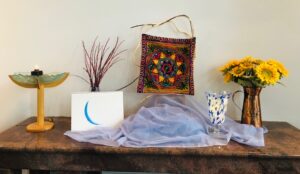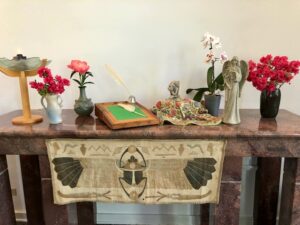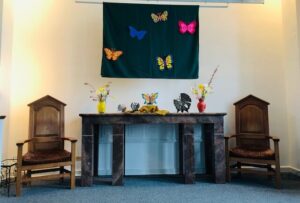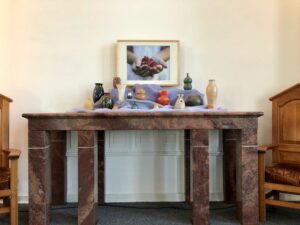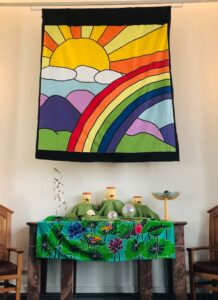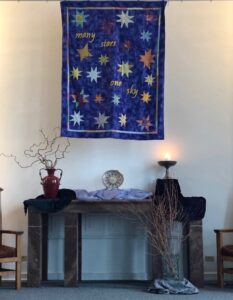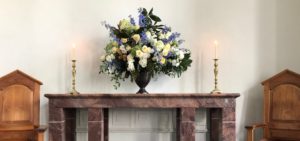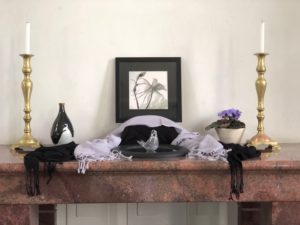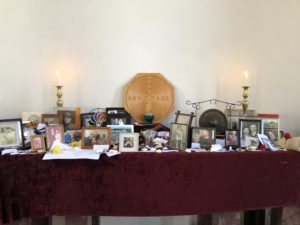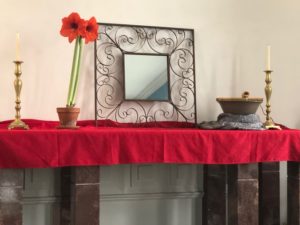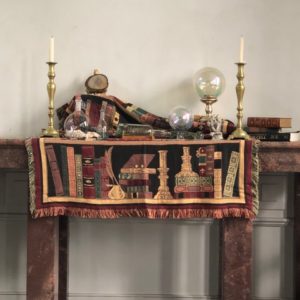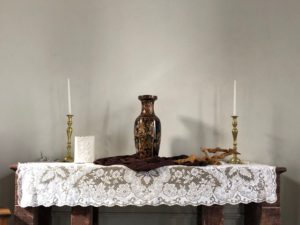You can find it in the myths and folklore of pretty much all Mesoamerican cultures; it shows up in lot’s of other cultures, too. Hungarians called it, “égig érő fa,” the Sky-High Tree, and “életfa,” the Tree of Life. To the Norse it was, “Yggdrasil,” the World Tree. At the base of which was the pool of the wise woman Mimir, on which Odin sacrificed himself to learn the secrets of the rune stones and of magic, and into which Lif and Lifthrasir will be hidden during Ragnarök so that after all the destruction they might emerge as the first man and first woman and start it all again. The World Tree motif shows up in religious myths throughout the world. It is an example of the axis mundi, the center, the pillar, of the world and the cosmos, and it connects the heaves – which rest on its canopy – the earth, and the underworld – into which its roots grow. In his book Creation of theSacred: Tracks of Biology in Early Religions, scholar Walter Burket suggests that because our ancient primate ancestors living in trees for roughly 60 million years, the idea of a world sustaining, life sustaining tree was coded in our DNA.
Trees aren’t just cosmic symbols, either. At a tree planting ceremony I attended some years ago, the worship leader noted that a remarkably large number of people, if asked, could name at least one tree that held a special place in their hearts. We went around the circle, and sure enough — everyone had a story. For one it was about a tree that one of their children planted when they were in elementary school, and how they watched that tree grow along with their child until it, too, became bigger than the house. Another person spoke about a tree on their grandparents’ property, in which they climbed when they were little, played in a treehouse when they were older, snuck out for a smoke under when they were older still, and how personal and painful it felt when that tree eventually had to be cut down. I remember someone else talking about how, while visiting Sequoia National Park, they were deeply moved by the realization of just how old those trees were, and how much of history they had witnessed. “If only those trees could talk,” they said. Maybe you can think of such a tree.
The Trappist monk, Fr. Thomas Merton, once wrote, “Nothing has ever been said about God that has not already been said better by the wind in the pine trees.” (Nature has often been called “God’s other Bible.”) Emerson talked about how being in the woods brought him to a profound spiritual place:
In the woods, we return to reason and faith. There I feel that nothing can befall me in life, — no disgrace, no calamity, (leaving me my eyes,) which nature cannot repair. Standing on the bare ground, — my head bathed by the blithe air, and uplifted into infinite space, — all mean egotism vanishes. I become a transparent eye-ball. I am nothing. I see all. The currents of the Universal Being circulate through me; I am part or particle of God.
I’ve known many people who, when things are hard, find a tree to rest against, to feel through their backs its strength and stability. Maybe you have, too.
This morning I want to explore this symbol, the tree, in an even more personal way. But first, a little science:
There are five structures that make up a tree: roots, trunk, branches, leaves, and seeds.
Roots are usually the first part of a plant to emerge during germination, and they have two primary purposes: to bring water and nutrients from the soil up into the tree, and to provide stability. Some plants have roots that grow deep; others spread themselves wide. In her poem “Connections Are MadeSlowly” (which is number #568 in our hymnal, and is also called, “The Seven of Pentacles”), the poet Marge Piercy reminds us that “more than half a tree is spread out under your feet.”
When I looked up the purpose of the tree trunk, what I found again and again was the simple statement that it’s what connects the roots to the canopy, the foliage at the very top of the tree. It is the in-between. You might be tempted, as I was, to think that this makes it the reason for a tree’s existence, since nutrients come down to it from the leaves, and up to it from the roots. It is more accurate to say that the seed is the purpose of the tree, the continuation of the species, and so we come again to the role of the tree being that which connects the roots and the canopy.
There are four parts to the trunk – the bark, cambium, xylem, and heartwood. The bark, we know, because it’s the part we see, the outermost part that, like our epithelial layer, serves to protect the more delicate parts inside. And — again, like our skin — the outer bark is made up of dead cells. I say “outer bark” because there’s an inner bark that’s quite a bit different. It has its own name – phloem – yet it’s not consider a separate part of the tree. The phloem is filled with, made up of, tubes, like drinking straws, and it is through these tubes that the water and nutrients the roots have taken from the soil pass up into the tree.
I’m going to skip over the cambium, the next layer, for a moment, and direct our attention to the xylem. This is sort of like a reverse phloem. The xylem is also made up of straw-like tubes, only these are what bring the food created by the leaves’ photosynthesis down to the rest of the tree. Eventually, though, the cells of the xylem die, and it becomes part of the heartwood, the very center of the tree, a dead layer that provides the tree’s stability.
I skipped over the cambium, the layer between the phloem and the xylem, because, if I’ve understood what I read correctly, it’s made up of cells that can become either of those other two layers depending on the tree’s needs — it can become phloem or xylem. Like our stem cells, I suppose, the cells of the cambium become what’s needed of them, and in a very real sense they’re what makes the growth rings as the tree ages.
So that’s the roots and the trunk. (And I promise, the science lesson will be over soon, but all of this is important background to get the most out of the tree’s symbolism as I want to talk about it this morning.) The branches are the tree’s way of getting the leaves out into the sunlight. That’s why they grow the way they do, twisting this way and that, growing around things, even getting entangled with other things. Yet if you really look at them, they’re always moving upward. Branches are the vehicle the tree uses to move the leaves to the places where they’ll get maximum exposure to the sun. This makes it possible for leaves to work their magic of photosynthesis, turning sunlight, air, and water into sugar, the food the tree most needs.
And as I suggested earlier, you could say that the purpose of all of this – the reason for the roots, trunk, branches, and leaves – is so that the tree can produce seeds, whether in fruit, wings, cones, or husks. The purpose of the tree is its propagation, the eternal perpetuation of itself, its species.
Okay. So. Here we go:
Let’s say that the trunk is us. You, me; any of us. We, like the trunk of the tree, live between the roots which go down (metaphorically, into the past), and upward to the leaves, the canopy (which can be seen as a metaphor for the future).
We draw on those who came before, drawing into us all the legacy they have left us: the strength, the wisdom, the foibles and follies, even the lessons we can gleam from their failures. This inheritance nourishes us. The image on the wall behind me [and above] may look like a traditional family tree, yet it is different. It was designed with the special needs of adopted families in mind, because families created through adoption do not have a single path for their roots. My children are connected to the ancestors of their birth parents, and even though we’re not related by blood, they are connected to my ancestors and those of my wife. And their children, and their children’s children, will also have this wider lineage.
Looking at the roots of a family tree in this way is good for non-adoptive families. Each of us, all of us, have ancestors who support us, who provide us with sustenance, from whom we draw spiritual and emotional nourishment, who are not related to us by blood. Next Sunday is our annual Ancestors Sunday service, a part of which is the creation of an ancestors altar onto which we place photographs, mementos, and other objects to recognize and honor these roots — all of these roots. (So remember to bring your objects with you!)
For us, today, we are the trunk. We, too, have a layer of emotional and spiritual protection, and it’s often made up for the most part of assumptions, habits, and patterns of our past which no longer serve us. Which, in a sense, are no longer really “alive.” This isn’t necessarily bad – these things have served us in the past, and they can still provide the protection we need. But not always. Sometimes we have to be like the Shagbark Hickory, certain varieties of Maple, and the White Birch, which shed their bark regularly. It is a beautiful thing to come across these peelings which have exposed a new (and renewed) layer of protection for the tree.
It’s worth noting, too, that this outer layer largely made up of outmoded parts of our histories is intimately tied to the part of us which is drawing up the gifts of our ancestors. They are not unrelated. Together, they both help us to weather the … well … weather.
We also draw sustenance from our futures, odd as that might seem. We, too, are here in large part for them, those who have not yet come. I often say that our congregation must be strong and healthy now, not only for ourselves, but also for those who haven’t yet come. Just as our ancestors planted this community 75 years ago, we, too, are preparing for future generations.
If we are wise, if we are grounded, then we also have a part of ourselves, a dimension of our consciousness, our hearts, our spirit, (call it what you will,) that adapts to the needs of the moment, helping us to discern what will feed us most, right here and right now. Do we call upon our ancestors, our past, our inheritance, or in this instance do we really need to draw strength from the future? Like the tree’s cambium, it is good to be able to adapt as needed.
Then there’s the heartwood … perhaps that’s just what it sounds like, for in a very real sense it is our hearts which provide us with our greatest strength and stability.
Maybe you’re already ahead of me. Our branches are the ways we reach out to the warm glow of relationships. We humans are a communal species; you and I were not built to go it alone. Sometimes the route to real relationships is circuitous; sometimes we have to wend and wind our way to get there. If we listen deeply and well, we will always be moving toward love.
Then there are the leaves, the interactions, the kindnesses done, the generosity shown, the gifts shared – these things make that love real, and make it possible for us to produce seeds that will live on. A recurrent theme in virtually every memorial service I’ve ever officiated is that the person being remembered, mourned, and celebrated had lived a life that would live on in the memories, in the lives, of the people who remain. Over and over again I’ve heard people say, essentially, that they intend to move forward from their loss with something of their loved one inside them, growing, shaping their futures. And, of course, these same people talk about how they hope to pass these gifts on to their children, and their children’s children, and on through the generations to come.
Leaves, branches, trunk, and roots,
It takes all of the tree to be a tree.
If any part were missing,
Or different,
It could not be what is.
Neither can we.
Leaves, branches, trunk, and roots,
Where we came from,
Who we are,
And where we’re going
Is what makes us, us.
May we learn the lessons of the trees.

